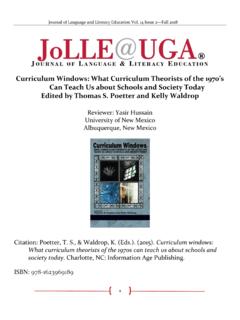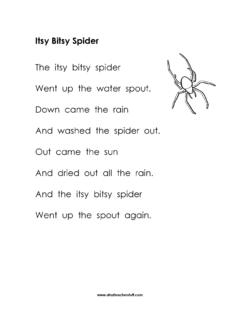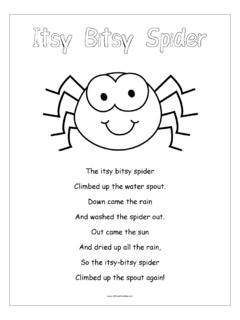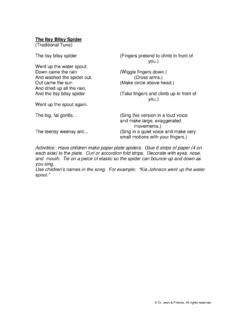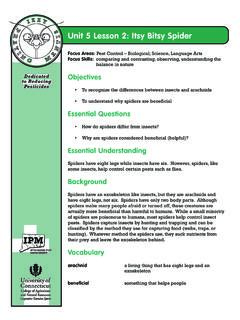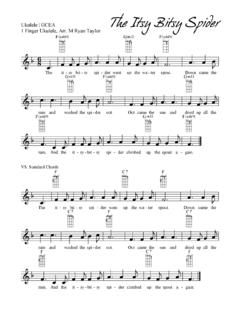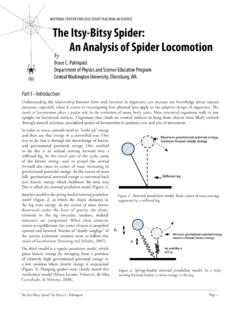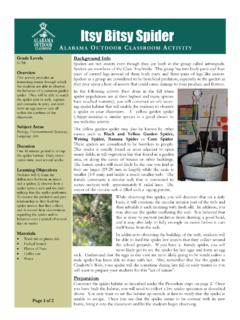Transcription of Nursery Rhyme Knowledge and Phonological Awareness in ...
1 THE JOURNAL OF LANGUAGE AND LITERACY EDUCATION 65 Citation Harper, L. J. (2011). Nursery Rhyme Knowledge and Phonological Awareness in preschool children. The Journal of Language and Literacy Education [Online], 7(1), 65-78. Nursery Rhyme Knowledge and Phonological Awareness in Preschool Children Laurie J. Harper University of Rhode Island Phonological Awareness is an important precursor in learning to read. This Awareness of phonemes fosters a child s ability to hear and blend sounds, encode and decode words, and to spell phonetically. This quantitative study assessed pre-K children s existing Euro-American Nursery Rhyme Knowledge and Phonological Awareness literacy, provided Phonological Awareness training with an experimental group of children and investigated the effects of explicit Nursery Rhyme instruction on participants phonemic skill levels. These data reveal that children exposed to the intervention consisting of explicit Euro-American Nursery Rhyme instruction significantly outperformed the children in the control group on Rhyme Awareness and completion statement measures.
2 Results of this research suggest that Knowledge of Nursery rhymes enhances children s Phonological Awareness and sensitivity to individual phonemes and Rhyme , and stimulates phonemic skill development. Keywords: Phonological Awareness , pre-k, kindergarten, and emergent literacy THE JOURNAL OF LANGUAGE AND LITERACY EDUCATION 66 Introduction A growing body of research affirms the link between children s early language skills and later reading abilities (Bryant, Maclean, & Bradley, 1990; Bryant, Maclean, Bradley, & Crossland, 1990; Strickland & Shanahan, 2004; Yopp & Yopp, 2000). The critical role of Phonological Awareness in the development of learning to read has long been established as a precursor to the acquisition of the alphabetic principle the understanding that the letters of the alphabet represent phonemes in speech (Dickinson & Tabors, 2001). This Awareness and understanding of phonemes fosters a child s ability to hear sounds, blend sounds, encode and decode words, and to spell phonetically.
3 One important aspect of literacy preparation is teaching children Phonological Awareness . Children entering kindergarten are expected to have an understanding of the sound-based system of our language, including rhyming skills and beginning letter sounds (Lonigan, Burgess, & Anthony, 2000; Snow, Burns, & Griffin, 1998). Many educators believe that before children begin reading instruction, they need to become explicitly aware that spoken words are composed of sounds; children therefore must develop the ability to consciously and analytically hear, identify, and manipulate those sounds (IRA & NAEYC, 1998; National Reading Panel, 1990; Sadlier-Oxford, 2000; Yop & Yop, 2002). Research reveals that there is a link between Nursery Rhyme Knowledge of preschool children and their future success in reading, writing, and spelling. Bradley and Bryant (1983, 1985) report that sensitivity to Rhyme and alliteration prior to a child s entry to formal schooling plays a causal role in their reading success several years later.
4 Furthermore, in their research the authors reported that receiving explicit instruction and training in the areas of alphabetic principles, rhyming, identification of words and alliteration strongly and positively affected children s reading ability. In a subsequent longitudinal study (MacLean et. al. 1987), authors provided systematic evidence that Knowledge of Nursery rhymes played a role in children s Phonological development. Covering a 15-month period, beginning when children were age , data was collected to measure children s Knowledge and growth of five common Nursery rhymes. Findings reported that children s initial Nursery Rhyme Knowledge was a powerful predictor of their growing skill in Rhyme and alliteration detection tasks over the next year and a quarter. Bryant and et. al. (1989) reported further longitudinal data from a group of 64 children ranging from ages to 6, covering a three year period supporting the hypotheses that acquaintance with Nursery rhymes positively affects children s reading ability.
5 Data report a strong relation between early Knowledge of Nursery rhymes and success in reading and spelling, despite differences in social background, intelligence quotient, and beginning Phonological skills. Torgesen (2002) reviewed research-based practices in early reading instruction and found that Phonological Awareness is a valid predictor for the identification of children at risk for reading problems. In a recent study, Vloedgraven and Verhoeven (2007) found that rhyming performance; and the skills of phoneme identification, blending and segmentation are vital aspects of Phonological Awareness . These authors also revealed that the most informative, yet most difficult and discriminating task of children s Phonological Awareness ability is phoneme segmentation, while rhyming performance appears to be the easiest. Additional research which investigates the relationship between a child s Nursery Rhyme Knowledge and their levels of Phonological Awareness skills is needed.
6 This paper reports an investigation of the relationship between Knowledge of Nursery rhymes and phonemic skill development in 20 three-year old pre- K children. T he effect of explicit Nursery Rhyme THE JOURNAL OF LANGUAGE AND LITERACY EDUCATION 67 instruction on children s Phonological Awareness and phonemic skill development in Nursery Rhyme recall, Rhyme identification, and beginning sound Awareness was assessed. Purpose of Study This quantitative study assessed pre-K children s existing Euro-American Nursery Rhyme Knowledge and Phonological Awareness literacy, provided Phonological Awareness training with an experimental group of children and investigated the effects of explicit Nursery Rhyme instruction on participants phonemic skill levels. Two questions were addressed: 1. How much Knowledge of Nursery rhymes do pre-K children have, and 2. Does explicit instruction of Nursery rhymes combined with kinesthetic and hands-on activities increase a preschool child s Phonological Awareness ?
7 More precisely, does it increase a child s ability to recall Nursery rhymes, identify rhymes, identify beginning sounds, and become more phonologically aware of the sounds of the English language? Methods Participants Study participants consisted of 20 three-year old pre-K children and their teachers from a lower middle class inclusive preschool in the Northeastern United States. Of the preschool participants 11 were female and nine were male; 18 were Caucasian, one child was African-American, and one child was Asian-American. Although all of the children s primary and native language used in the home was English, four children were classified with minor disabilities in speech and language delays. Both teachers were female, Caucasian, and highly experienced with 23 and 17 years teaching experience. The 20 participants in this study were previously assigned to two separate classrooms during the previous August by school personnel.
8 This inclusive pre-school setting strives to maintain classroom heterogeneity determined by gender, ability and socio-economic status. The assignment of a group as experimental or control in this study was determined randomly (by the flip of a coin). The control group had nine participants and the experimental group had 11 participants. Measures Two measures were administered individually to all study children in the context of their pre-K classroom at the beginning and end of the study. Measures used to assess participants existing Nursery Rhyme Knowledge and Phonological Knowledge included Nursery Rhyme Completion Statements (Harper, 2008) and a revised Phonological Awareness Literacy Screening for Preschool (PALS Pre-K, often referred to as pre-K PALS) (University of Virginia, 2004). Nursery Rhyme completion statements. A completion statement tool composed of visual and auditory cues in PowerPoint format was designed to assess children s existing Knowledge of ten common Nursery rhymes.
9 Nursery rhymes included Humpty Dumpty, Twinkle Twinkle Little Star, Itsy bitsy spider , Jack and Jill, Hey Diddle Diddle, Hickory Dickory Dock, Mary Had a Little Lamb, Baa-Baa Black Sheep, Little Boy Blue, and Little Miss Muffet. Participants were shown a series of PowerPoint slides of the ten Nursery Rhyme s listed above and asked if they knew who the pictures represented (Figure 1). Participants were given two prompts if they were unable to answer. The child s answer was recorded as correct given the initial statement, prompt #1, or prompt # 2. If the child answered correctly, s/he was given one point; if s/he was not able THE JOURNAL OF LANGUAGE AND LITERACY EDUCATION 68 to recall the Nursery Rhyme the child did not receive a point. Additionally, children were asked where they learned these Nursery rhymes. Their responses were recorded along with additional information concerning their Nursery Rhyme Knowledge and their ability to respond to the completion statement task.
10 Phonological Awareness literacy screening for preschool (PALS-Pre-K). PALS-Pre -K is a scientifically-based Phonological Awareness and literacy screening tool that measures preschoolers' developing Knowledge of important literacy fundamentals. This assessment reflects skills that are predictive of future reading success and measure young children s Knowledge of fundamental aspects of Phonological Awareness and print Knowledge . This assessment tool is valid, reliable, and standardized on very large samples of children (Invernizzi, Sullivan, Swank & Meier, 2004). Select segments of the Pre -K- Pals Phonological test were revised and administered to all study children in an individual format using oral assessment procedures to determine a baseline score of Phonological Awareness and individual levels of phonemic skill development. Although the Pre -K- Pals test tasks include: (a) name writing, (b) alphabet recognition and letter sounds, (c) beginning sound Awareness , (d) print and word Awareness , (e) Rhyme Awareness , and (f) Knowledge of Nursery rhymes, only the tasks in beginning sound Awareness , Rhyme Awareness , and Knowledge of Nursery rhymes were administered to study children since all study participants were only three years old and had no prior formal school experiences.
